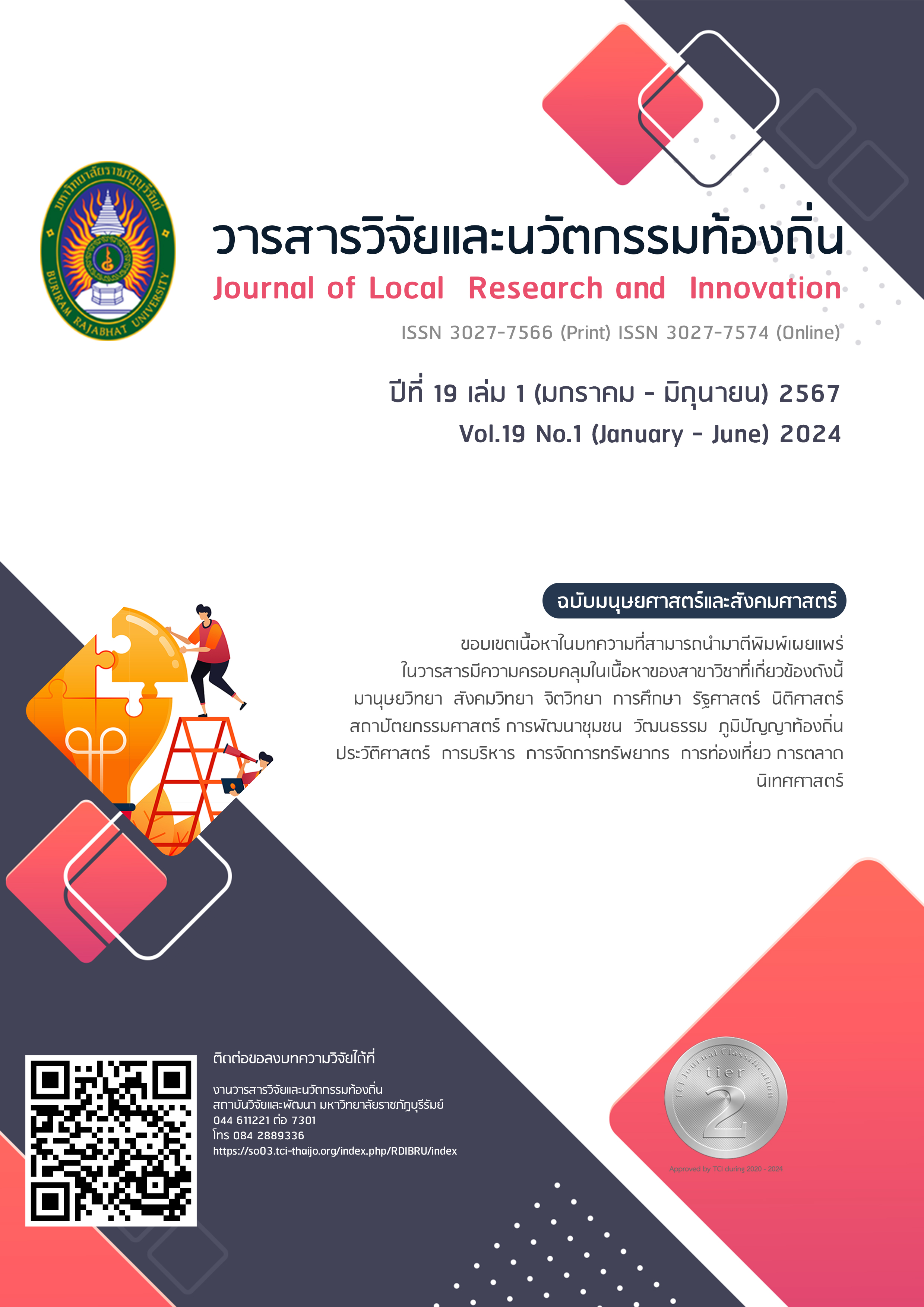Puranathanyaka : Decoding of Symbols From Prasat Hin Phanom Rung Etched Image to the Creation of Performing Art
Main Article Content
Abstract
Thesis on Puranathanyaka: Deciphering the meaning from the carvings of Phanom Rung Stone Castle. Towards the creation of contemporary Thai dance have a purpose 1) To study the etched images “Purana Thanyaka Ceremony” at the main castle gate porch of Phanom Rung Stone Castle. Chaloem Phra Kiat District Buriram Province 2) To create contemporary Thai dance from the study of etched images. “Purana Thanya Ceremony” of Prasat Hin Phanom Rung Chaloem Phra Kiat District Buriram Province by studying documents Related research and field data through observation and interviews The tools used to collect data include observation forms and interviews. From a group of knowledgeable people Practitioner group and the general public Then present the research results by summarizing and discussing the results in a descriptive and analytical manner.
The results of the study found that the main images of the Puranathanka ceremony or the "auspicious grain sowing ceremony" is a sacred ritual and historical evidence that inscribes traces of beliefs, traditions, and ways of life of people in the ancient Khmer culture. It is the epitome of the belief of ensuring abundance at the beginning of the human farming season in any era. Leading to the creation of contemporary Thai dance that expresses its cultural roots and can reflect the present. By deciphering the meaning and interpreting the meaning from the original image. imitation and picture elements Through the theory of creating dance in 10 steps, divided into 3 periods of expression: 1st period Mantravanamrung, 2nd period Sattha, and 3rd period Puranathanyaka, which reflects the concept of bringing historical evidence. Create and combine the science of dance in order to create cultural capital that is a local identity Links to tourism in historical places, creates an economy in the community and preserves the heritage, wisdom, culture, and beliefs that are the primary reason for the First Na Kwan Ceremony. social community couple and the nation continues
Article Details

This work is licensed under a Creative Commons Attribution-NonCommercial-NoDerivatives 4.0 International License.
เนื่อหาและข้อมูลในบทความ เป็นความรับผิดชอบของผุ้แต่ง
บทความในวารสารเป็นลิขสิทธิ์ของวารสารวิจัยและพัฒนา มหาวิทยาลัยราชภัฏบุรีรัมย์
References
ชาญณรงค์ พรรุ่งโรจน์. (2548).การวิจัยทางศิลปะ. พิมพ์ครั้งที่ 2. กรุงเทพฯ: สำนักพิมพ์แห่งจุฬาลงกรณ์.
ชนิดา จันทร์งาม. (2561).การสร้างสรรค์นาฏยศิลป์เพื่อสะท้อนภาพลักษณ์ของสตรีอีสานผ่านการชมหนังกลางแปลง.
วิทยานิพนธ์.
ดารณี จันทมิไซย. (2563).ฟ้อนผู้ไทในจังหวัดกาฬสินธุ์. ลพบุรี: โรงพิมพ์นาฏดุริยางค์.
ธัญญนันท์ เนาวรัตน์. (2565). เทวะ ภูพระอังคาร : การสร้างสรรค์นาฏกรรมร่วมสมัยจากใบเสมา วัดเขาอังคาร จังหวัดบุรีรัมย์. วิทยานิพนธ์.
มณิศา วศินารมย์. (2565). อำนาจ วัฒนธรรม: รำวงมาตรฐาน. วิพิธพัฒนศิลป์.
รักษ์สินี อัครศวะเมฆ. (2563). นาฏศิลป์กับการประยุกต์อุปกรณ์ตามแนวคิดหลังสมัยใหม่.บทความวิจัย
วัฒนะ จูฑะวิภาค. (2556).ศิลปะการออกแบบตกแต่งภายใน.กรุงเทพฯ : จูน พับลิชชิ่ง.
วรณัย พงศาชลากร. (2560).ปูรณะธัญกาแรกนาขวัญที่ปราสาทพนมรุ้ง.สืบค้นเมื่อ 28 กรกฎาคม 2566,
จาก https://www.oknation.net/post/detail.
ศักย์กวิน ศิริวัฒนกุล. (2565). การสร้างสรรค์นาฏศิลป์ในนิทรรศการ “108 พันก้าว”ครบรอบ 108 ปี โรงพยาบาลจุฬาลงกรณ์ สภากาชาดไทย.
ศิริมงคล นาฏยกุล. (2557).นาฏยศิลป์ตะวันตกปริทัศน์.มหาสารคาม : มหาวิทยาลัยมหาสารคาม.
สุขสันติ แวงวรรณ. (2565). การสร้างสรรค์งานทางนาฏศิลป์.ขอนแก่น : หจก.โรงพิมพ์คลังนานาวิทยา.
สุรพล วิรุฬห์รักษ์. (2547). หลักการแสดงนาฏยศิลป์ปริทรรศน์. กรุงเทพฯ : จุฬาลงกรณ์มหาวิทยาลัย.
สุริยวุฒิ สุขสวัสดิ์. (2549). ปราสาทเขาพนมรุ้งศาสนบรรบตที่งดงามที่สุดในประเทศไทย. สมุทรปราการ : สนพ.เรือนบุญ
Sandry Cerny Minton. (1997).Choreography: A Basic Approach Using Improvisation. Human Kinetics.

